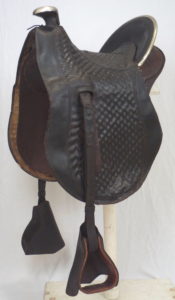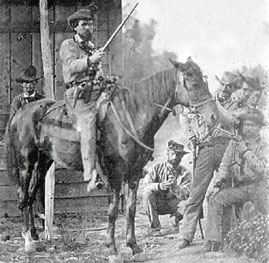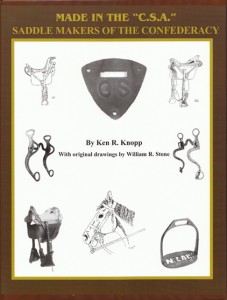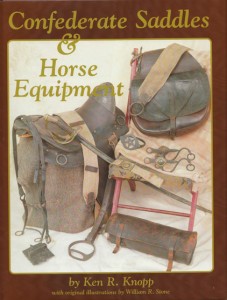Research on “all” historic 19th century American saddle patterns and horse equipment, 19th century leather production, Stable requisites, U.S. military saddlery, British & French saddlery, army wagons, military accoutrements, weapons, Cowboy era saddlery, 19th century clothing and more! Thousands of RARE images!
Questions? Contact Ken R. Knopp at…….. kenrknopp56@gmail.com (NEW!)
MY LATEST BOOK!! IN STOCK NOW!
AMERICAN RIDING & WORK SADDLES
(and Horse Culture) 1790 – 1920
See the “STORE” on THIS web site to order yours!
Here is a little about the book…
AMERICAN RIDING & WORK SADDLES (And Horse Culture) 1790 – 1920: Hard back, full color throughout! Nearly 300 pages with over 650 illustrations. Meticulously researched and fully footnoted! Expect quite a bit of new research information that confounds heretofore general knowledge of American saddlery along with photos of never before seen saddles from private and public collections.

Gorgeous and rare Spanish saddle c. 1840’s to early 1850’s made by Dicks & Waters of Natchez Mississippi.
NOTE: I am very proud to announce…..that historian B. Bryon Price has written the Forward. Mr. Price is no stranger to the subject matter. He has written, edited or co-authored over twenty books on the American West including “Saddles of the Frontier West”, “Fine Art of the West”, “Cowboys of the American West” and “Cowboy Spurs & their Makers”. In addition to television and movie consultant work, Mr. Price was former curator for several renown western museums including the National Cowboy Hall of Fame and Western Heritage Center in Oklahoma City, and the Buffalo Bill Historical Center in Cody, Wyoming. Currently, he is the Director of Charles M. Russell Center for the Study of Art of the American West at the University of Oklahoma and is the Director of the University of Oklahoma Press.
Book Overview: AMERICAN RIDING & WORK SADDLES (and Horse Culture), 1790-1920. It encompasses all the major American “non-military” riding and work saddles. The effort is to provide the origins, history and development of the major American “riding” and “working” saddle patterns, the saddle making industry and the American horse “culture” relative to our great country’s history. This will include the origins of their Spanish and English influences and the story of the rise and demise of American saddle manufacturing from the late 18th through early 20th centuries. This is NOT an effort to recapture the military saddle. That has been done quite well by others. Rather, it will cover all other major American saddle patterns: Spring seat, American, English, Wagon saddles, Somerset, Attakapas, Spanish, Half Spanish, Hope, Texas, California, Kilgore, Morgan, Morgan Muley, Kentucky Spring Seat, Wilbourne/Buena Vista, multiple Stock “Cowboy” saddles (Texas, Cheyenne, Pueblo, Miles City, Applehorn, etc.) and their California (o) influences, Ladies side saddles, Ladies Astride saddles, Princess saddles, Children’s/Youth saddles, Park & Police saddles and, commercial military saddles. Many others including some well known national commercial patterns and regional makes will also be included (Shaftoe, Shackleford, Granger, Ferguson, Race, Polo and Pad saddles,….McBride, Richardson, Ferguson, Florida, etc. ). Other historical topics related to the saddle manufacturing industry are covered as well: trees, leather, hardware, patents, manufacturing #’s, exports/imports, influential persons and regions, etc and,….The “Golden Age of the Horse”. Yes, a massive undertaking!
Of particular note will be inclusion of excerpts from the VERY FIRST American saddle catalog, The T. Smith & Co. catalog c. 1858, (today: Smith Worthington) made up of water color saddle illustrations commissioned by the iconic Hartford Connecticut saddle making firm. The saddle patterns and styles that were offered by this firm prior to the Civil War are incredible and will most certainly stand conventional wisdom and understanding of pre-war saddle patterns, on its head!
The breadth of this project is extensive including over 650 saddle photos and illustrations to enable one to identify 19th century saddles.
As Always, Check out my saddle and horse equipment photos in PHOTO GALLERIES! The ONLY place on the web to see such a wide assortment of “Pre-1900” saddlery! In addition, thousands of photos of civilian saddles, bridles, bits, stirrups, etc., Confederate and Federal Saddles, Confederate/Federal Horse Equipment, Dragoon and Indian War saddlery; photos of CW artillery teams, artillery horse equipment, quartermaster wagons and ambulances; mounted Federal and Confederate Cavalrymen images, imported English & French equipment, military and civilian clothing, accoutrements, weapons and more! All from public and private collections, some have NEVER before been published or seen the light of day. Over fifteen hundred images!
** CHECK THIS OUT!….. Several NEW images have recently surfaced showing “mounted Confederates! Some Identified!! Very RARE!! To date, I know of only about two dozen existing images of “mounted” CS soldiers. See them ALL NOW! Posted on the Galleries page, “Mounted Confederates tab”.
Overview: Horse Equipment in the Civil War

Just how important was horse equipment in the scheme of battlefield victories? Arguably, just as important as were arms, ammunition or any other article of military necessity. Despite the evolving tactics of mid-19th Century warfare, the cavalry and field artillery’s role nevertheless remained central to an army’s effectiveness.
Mounted cavalry served several important functions; as the virtual eyes and ears of the huge armies, their escorts and couriers, flankers and shock troops in battle, behind the lines as piercing raiders and partisans, and as an independent fighting force. For artillery, the deployment of field pieces into a battle, offensive and defensive tactics, pursuit of an enemy or even siege operations required artillery cannons to be mobile. Horses were the fastest and most reliable method of transportation at the time. Thus, for both branches the adequate supply of horse equipment and therefore their usefulness, was undeniably important.
From its uncertain beginnings to the war’s end, the history of Confederate saddle manufacturing is a cloudy and convoluted story of profound struggle. One might think that after the thousands of years that man has ridden the horse, by 1860, something so simple as the saddle would be universally acceptable in western civilization. However, the answer was not at all so obvious.
Throughout the four years of struggle for Southern independence there was a constant battle being waged within the Confederate Ordnance Bureaus’ arsenals to find and manufacture satisfactory cavalry and artillery saddles, bridle bits, saddle blankets even curry combs. Still, the Confederacy’s difficulties in adopting adequate horse furniture was not due to a lack of ingenuity nor was it unique to the South. The War Between the States occurred during a period of tremendous world wide change in the composition of riding saddles. For two hundred years Americans relied upon European influences to guide their preferences for saddles. However, since the 1820s, the Spanish (also referred to as ” Mexican”) methods of tree configuration and construction increasingly altered saddle designs for usefulness, durability and the comfort of both horse and rider. Most notably, the new design of the pommel, cantle and side bar, and the method of encasing the tree with wet rawhide for strength, significantly and forever changed the way Americans and others saddled the horse.
In the North, the pre war adoption of the McClellan and Grimsley horse equipment as generally described in the Ordnance Manual of 1861 set a standard that saw little substantive change throughout the conflict. Conversely, though the Confederacy was initially guided by the earlier Federal manuals and General Orders, in practice they instituted numerous changes. For both sides, the war provided the ultimate field test for its horse equipment but in stark contrast to their Northern counterparts, the Confederate Ordnance Bureau would prove intrinsically more flexible and less encumbered by bureaucracy when it came to the need for decisive change or adaption. When necessity dictated, which it often did, the bureau routinely utilized less than officially sanctioned materials and methods such as substituting enamelled cloth or rope for leather, hand forged instead of cast iron bridle bits, saddle blankets made from Spanish Moss and collars made of corn shucks. Some equipment evolved during the course of the war including both the artillery driver’s and valise saddles, traces, cavalry halters, and their most renown piece of equipage- the Jenifer cavalry saddle. In fact, its adoption, evolution and subsequent replacement by the McClellan and Texas saddles represent the most striking examples of the Confederate Ordnance Bureau’s fluidity.
For a far more complete and detailed overview we recommend you purchase Mr. Ken R. Knopp’s book: CONFEDERATE SADDLES AND HORSE EQUIPMENT.
SOLD OUT! MADE IN THE C.S.A. SADDLE MAKERS OF THE CONFEDERACY is OUT OF PRINT and SOLD OUT!!! 
The hardbound CONFEDERATE SADDLES & HORSE EQUIPMENT (still available at “full” price of $59 plus $8 shipping (USA only). Signed copies available but selling fast and now Out of Print!
Last updated: Jan. 20, 2024

